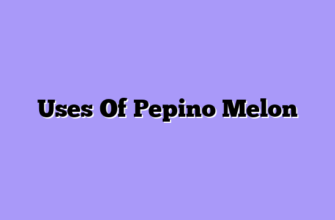Getting to Know the Pepino Melon
Before we dive into the nitty-gritty of propagation, let’s chat about what makes the Pepino melon so special. Picture this: a fruit that looks like it can’t decide if it wants to be a melon or a pear. That’s our Pepino for you! It’s got this smooth, speckled skin that ranges from pale yellow to purple, and when you bite into it, you’re hit with a flavor that’s somewhere between a honeydew and a cucumber.

But here’s the kicker: Pepinos aren’t your average backyard fruit. They’re native to South America, specifically the Andean valleys. So, bringing them to my farm in a completely different climate? That was going to be a challenge. But hey, who doesn’t love a good challenge, right?
What really fascinates me about the Pepino melon is its versatility. It’s not just a fruit – it’s a conversation starter, a culinary adventure, and a testament to nature’s creativity. And let me tell you, once you get the hang of growing these beauties, you’ll feel like you’ve unlocked a secret level in the farming game.
Preparing for Pepino Propagation
Alright, so you’re ready to jump into the world of Pepino propagation? Awesome! Let’s talk about what you need to get started. First things first: patience. I can’t stress this enough. Growing Pepinos is not a sprint; it’s a marathon. But trust me, the finish line is worth it.
Now, let’s get down to the practical stuff. You’re going to need:
- Healthy Pepino cuttings or seeds (I prefer cuttings, but we’ll get to that)
- Well-draining potting soil
- Containers or a prepared garden bed
- Rooting hormone (if you’re using cuttings)
- A warm, sunny spot (these guys love the sun!)
Before you start, take a moment to consider your climate. Pepinos are pretty adaptable, but they thrive in conditions similar to their Andean homeland. That means they love temperatures between 65-80°F (18-27°C). If you’re in a colder region, don’t worry! We’ll talk about some tricks to keep your Pepinos happy.
One thing I learned the hard way: soil preparation is key. Pepinos aren’t too picky, but they do love well-draining soil rich in organic matter. I like to mix in some compost or well-rotted manure before planting. It’s like giving your Pepinos a five-star hotel to grow in!
Propagation Methods: Cuttings vs. Seeds
Now, here’s where things get interesting. When it comes to propagating Pepinos, you’ve got two main options: cuttings or seeds. Both have their pros and cons, and I’ve tried both with varying degrees of success (and a few hilarious failures).
Let’s start with cuttings. This is my preferred method, and here’s why: it’s faster, and you know exactly what you’re going to get. Plus, there’s something oddly satisfying about watching a cutting develop roots. It’s like witnessing a little miracle!
To propagate from cuttings, I select healthy, disease-free stems about 6-8 inches long. I remove the lower leaves, dip the cut end in rooting hormone, and plant it in a pot filled with that well-draining soil we talked about earlier. Keep the soil moist but not waterlogged, and in about 2-3 weeks, you should see roots forming.
Now, seeds. Growing from seeds is a bit trickier and takes longer, but it’s a great option if you can’t get your hands on a live plant. Plus, there’s an element of surprise – you never know exactly what characteristics your Pepino might have! To start from seeds, sow them in small pots or seed trays filled with seed-starting mix. Keep them warm (around 70°F or 21°C) and moist, and you should see sprouts in 2-3 weeks.
Nurturing Your Pepino Plants
Alright, so you’ve got your Pepinos started. Congratulations! But don’t pop the champagne just yet – the real work is just beginning. Nurturing your Pepino plants is where the magic happens, and it’s also where I’ve learned some of my most valuable lessons.
First up: sunlight. Pepinos are sun-worshippers. They need at least 6 hours of direct sunlight daily. I learned this the hard way when I tried growing them in a partially shaded area. The plants grew, but the fruit production was disappointing. So, find the sunniest spot in your garden and let your Pepinos soak up those rays!
Water is another crucial factor. Pepinos like consistent moisture, but they’re not fans of wet feet. I water mine deeply once or twice a week, depending on the weather. A good rule of thumb: stick your finger about an inch into the soil. If it’s dry, it’s time to water. If it’s still moist, give it another day.
Now, let’s talk food. Pepinos are moderate feeders, but they do appreciate a good meal. I use a balanced, water-soluble fertilizer every 2-3 weeks during the growing season. But here’s a tip: ease up on the nitrogen once the plants start flowering. Too much nitrogen can lead to lush foliage but poor fruit production.
One thing that caught me by surprise was how much Pepinos love to sprawl. They’re technically a perennial herb, but they grow more like a vine. I provide support using trellises or cages, similar to what you’d use for tomatoes. This not only keeps the fruit off the ground but also makes harvesting a breeze.
Dealing with Pests and Diseases
Now, I wish I could tell you that growing Pepinos is all sunshine and rainbows, but let’s get real – every farmer faces challenges, and Pepinos have their fair share. The good news? Most of these issues are manageable if you catch them early.
The usual suspects in my Pepino patch are aphids and spider mites. These tiny troublemakers can wreak havoc if left unchecked. I’ve found that a strong spray of water can dislodge them, but for more serious infestations, I use insecticidal soap. It’s effective and doesn’t leave harmful residues on the fruit.
Fungal diseases can also be a problem, especially in humid conditions. I’ve battled powdery mildew more times than I’d like to admit. The key here is prevention: ensure good air circulation around your plants, avoid overhead watering, and remove any infected leaves promptly.
One unexpected issue I encountered was sunscald. Yes, even though Pepinos love sun, too much direct sunlight can damage the fruit. I learned to use shade cloth during the hottest part of the day, especially when the fruits are developing.
Remember, a healthy plant is more resistant to pests and diseases. So, focus on providing optimal growing conditions, and you’ll be ahead of the game.
Harvesting Your Pepino Melons
After months of care and anticipation, we’ve finally reached the most rewarding part: harvest time! There’s nothing quite like plucking that first ripe Pepino from the vine. But how do you know when they’re ready?
Here’s the tricky part: Pepinos don’t always change color dramatically when they’re ripe. Instead, look for a slight give when you gently squeeze the fruit. The skin should have a slight golden hue, and you might notice a sweet aroma at the blossom end.
I usually start checking my Pepinos about 30-40 days after the flowers appear. If you’re unsure, it’s better to leave the fruit on the vine a bit longer. Unlike many fruits, Pepinos continue to ripen after picking, but they’re most flavorful when allowed to mature on the plant.
When harvesting, use clean, sharp scissors or pruning shears to cut the fruit from the vine. Don’t pull or twist – this can damage both the fruit and the plant. Handle your Pepinos gently; they bruise easily, and nobody likes a bruised Pepino!
Now, here’s a little secret: not all Pepinos on a plant will ripen at the same time. This is actually great news because it means you’ll have a steady supply over several weeks. I usually harvest every few days during peak season.
Wrapping Up: The Joy of Pepino Propagation
Well, folks, we’ve come to the end of our Pepino propagation journey. From tiny seeds or cuttings to juicy, aromatic fruits, it’s been quite the ride, hasn’t it? As I sit here, enjoying a freshly harvested Pepino (or should I say, melon pear?), I can’t help but reflect on why I love growing these quirky fruits so much.
It’s not just about the unique flavor or the satisfaction of biting into something you’ve nurtured from the start. It’s about the challenge, the learning process, and the connection to nature. Every time I propagate a new batch of Pepinos, I feel like I’m part of something bigger – preserving a piece of South American heritage and introducing others to the wonders of this underappreciated fruit.
Sure, there have been setbacks along the way. I’ve lost plants to pests, battled unpredictable weather, and sometimes questioned why I didn’t just stick to growing apples. But you know what? Those challenges make the successes all the sweeter. There’s nothing like the feeling of biting into a perfectly ripe Solanum muricatum that you’ve grown yourself.
So, whether you’re a seasoned farmer or a curious gardener, I encourage you to give Pepino melons a try. They may not be the easiest fruit to grow, but they’re certainly one of the most rewarding. And who knows? You might just fall in love with these little oddballs, just like I did.
Happy planting, and may your Pepinos be plentiful and sweet!








